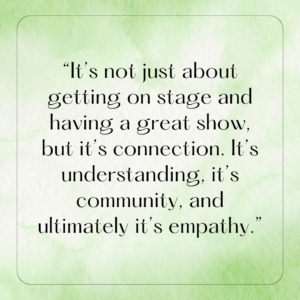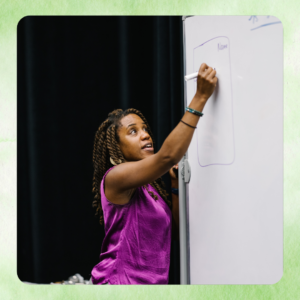At Gaynor, drama is more than just the skits at the Winter Concert or the annual Spring Musical. It’s a key element of the curriculum beginning in the Lower School, where students learn the fundamentals of acting and how those skills can be applied both onstage and in real life.
Taught by Drama Specialist Meredith Akins, drama at Gaynor starts in the Orange Cluster, where students learn the foundational exercises they will need as they move on to the upper clusters. The most important exercise that Orange Cluster students learn is unpacking the “actor’s toolbox.” The toolbox is a great way for the students to understand that, just as a doctor or a construction worker has tools to do their job, an actor has them as well. The actor’s toolbox includes having awareness and control of your voice, having awareness and control of your body, and using imagination, cooperation, concentration, and expression. As Ms. Akins describes it, every activity the students work on in class is, in some way or another, getting them to practice using those tools.
Once they learn the toolbox, students from Orange to Blue Clusters start out each class with a warm-up to refresh their memory of what the different tools are, and how they use them. Ms. Akins asks the students to become aware of having awareness and control of their bodies and voices. Students lift their arms up, imagining they’re plucking an apple from a tree, or reaching up to a high shelf. They then spread their arms out to the side, both stretching and telling the other students to come together, to cooperate. To finish the warm-up, they stand in actor’s neutral for ten seconds. Actor’s neutral means there is no posing or emotion, so the students’ faces and bodies are completely neutral. Then Ms. Akins will say “3, 2, 1, click”, and give them an expression that they need to pose as. Reflecting on this warm-up, Ms. Akins said, “I’m reminding them these are the tools in the actor’s toolbox for telling a story, but it’s also classroom management. You’re agreeing to what is necessary [for class] and then making it a kinesthetic thing also. Then they can reflect [after class is over] like if something didn’t go well, what did we not use?”
 Ms. Akins also stresses the importance of empathy and understanding emotion in drama, saying, “When all is said and done, acting is about understanding the human emotion and experiences so that you can understand some of these feelings and then tell that story.” She explored this with the Yellow Cluster this year, by way of a Korean folk tale called “The Tiger’s Whisker.” In this folk tale, a wife is frustrated when her husband returns from war and is no longer the happy man he used to be, and she needs to get a whisker from a live tiger in order to make a potion to “fix” him. Over time, she uses patience, kindness, compassion, and empathy to befriend the tiger so she can get its whisker, but by then she doesn’t need it any more. She has the tools to understand and help her husband.
Ms. Akins also stresses the importance of empathy and understanding emotion in drama, saying, “When all is said and done, acting is about understanding the human emotion and experiences so that you can understand some of these feelings and then tell that story.” She explored this with the Yellow Cluster this year, by way of a Korean folk tale called “The Tiger’s Whisker.” In this folk tale, a wife is frustrated when her husband returns from war and is no longer the happy man he used to be, and she needs to get a whisker from a live tiger in order to make a potion to “fix” him. Over time, she uses patience, kindness, compassion, and empathy to befriend the tiger so she can get its whisker, but by then she doesn’t need it any more. She has the tools to understand and help her husband.
After learning this story, the students then explored the story and the emotions of the characters using what is known as a process drama. In this exercise, they discuss the conflict, create a space of empathy, and work to find ways to problem-solve and find a solution. An example is the students taking on the roles of other tigers in the forest while Ms. Akins played the tiger who is meeting with the wife. The conflict between them is that some of the other tigers are scared to trust this human, and they don’t want the tiger to see her any more. But other tigers in the group recognize that the wife is bringing food to the tiger, and maybe she could bring the rest of the tigers food as well. By putting themselves in these roles, the students were working to understand the emotions of the other characters.
 Ms. Akins said, “It was so cool that they all had different [solutions]… When you do a process drama, you’re allowing each student to be ‘the expert.’ They’re allowed to, without fear, be wrong, because they’re playing a role. And it almost takes that fear of being wrong away from the situation.” The process drama becomes a safe space for the students to test different reactions to a scenario, and see how they can come to a healthy conclusion for everyone involved. This can be related to the world not only outside the drama classroom, but outside of Stephen Gaynor School as well. Ms. Akins noted, “Again, acting is really truly about having empathy for your characters, and that transposes to having empathy for other people in life. When I teach drama, why I’m so steadfast about it is, it’s not just about getting on stage and having a great show, but it’s connection. It’s understanding, it’s community, and ultimately empathy.”
Ms. Akins said, “It was so cool that they all had different [solutions]… When you do a process drama, you’re allowing each student to be ‘the expert.’ They’re allowed to, without fear, be wrong, because they’re playing a role. And it almost takes that fear of being wrong away from the situation.” The process drama becomes a safe space for the students to test different reactions to a scenario, and see how they can come to a healthy conclusion for everyone involved. This can be related to the world not only outside the drama classroom, but outside of Stephen Gaynor School as well. Ms. Akins noted, “Again, acting is really truly about having empathy for your characters, and that transposes to having empathy for other people in life. When I teach drama, why I’m so steadfast about it is, it’s not just about getting on stage and having a great show, but it’s connection. It’s understanding, it’s community, and ultimately empathy.”

